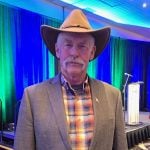A year ago, all signs were positive for honey producer Mark Friesen. Prices were above $2 per pound, winter hive losses were low and 2015 was shaping up as a profitable year for beekeeping.
Come fall, after months of harvesting honey, Friesen’s expectation of success met a surprising obstacle: no one wanted to buy his honey.
“I started calling around looking for honey prices and there was really no market,” said Friesen, who lives near Morden, Man.
“A lot of purchasers, packers and brokers were telling me that they weren’t even interested in buying at all.”
Read Also

Chinese, Indian tariffs take toll on pea prices
The disruption of pea exports from Canada’s largest customers will likely result in slow pea exports for the remainder of the crop year.
Friesen isn’t the only prairie beekeeper lacking a market. There is a glut of honey in Canada and prices have fallen accordingly. Friesen sold one lot of honey for $1.25 per lb., approximately $1 per lb. lower than prices in early 2015.
“(There’s) a lot of honey not moving. It’s not being sold,” said Friesen, adding about half of the 2015 Canadian crop remains in storage.
A number of beekeepers say Canadian honey packers are partly to blame. In March, Allan Campbell, a honey producer from Dauphin, Man., started an online petition against the country’s largest packer, Billy Bee.
The petition said Billy Bee, and its parent company McCormick, is refusing to buy Canadian honey and accuses the firm of purchasing cheap honey from China and Argentina to boost profits.
The petition, asking honey packers to buy Canadian honey first, now has nearly 74,000 signatures. Billy Bee said the accusations aren’t valid because it buys 85 percent of its honey from Canadian beekeepers, with the remainder coming from Argentina and China.
Friesen, who spoke at a Keystone Agricultural Producers (KAP) meeting in Portage la Prairie April 21, said the label on honey is part of the problem. Honey is labelled according to grade, such as Canada #1 white, which suggests it’s a product of Canada.
In fact, the bottle may contain mostly foreign honey and can still say Canada #1.
“If you look on the back of any honey container you’ll see the ingredients list,” Friesen said. “It (might) say, first of all, Chinese honey, Argentina honey and third of all, Canadian honey.”
The Canadian Honey Council wants the federal government to simplify honey labelling and provide clear information on country of origin.
Friesen brought forward a resolution at the meeting in Portage, asking KAP members to throw their support behind the honey labelling initiative.
The resolution sparked a 20-minute debate, as many producers had concerns about country-of-origin labelling.
“As a consumer I would… prefer to buy Canadian only,” said Bill Campbell, a cattle producer from Minto, Man. “(But) there’s more to this than just meets the eye…. If you are in a trade position and want to protect your industry, you’ll protect it domestically but you may lose trade markets…. It’s been stated before: be careful of what you ask for.”
Canadian beekeepers definitely depend on trade because about half of all honey is exported, with 80 to 90 percent going to the United States, according to the Canadian Honey Council website.
KAP members committed to support beekeepers and lobby for honey labelling clarity, but a sizable number voted against the initiative.















